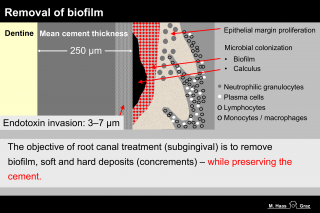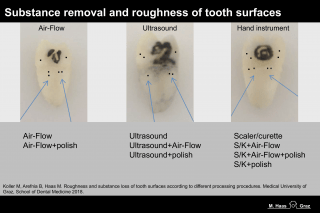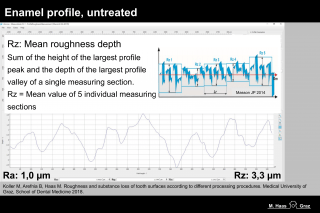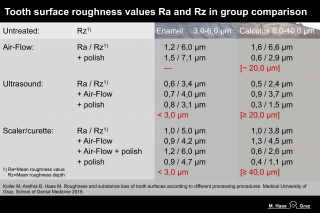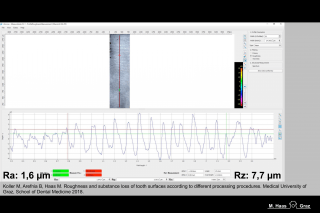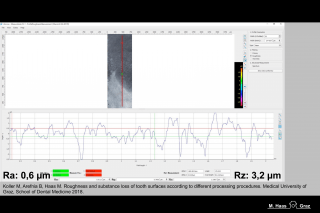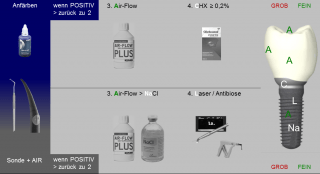ROUGHNESS AND LOSS OF SUBSTANCE OF TOOTH SURFACES AFTER BIOFILM REMOVAL WITH DIFFERENT PROCESSING METHODS
The objective of this pilot study was to investigate the roughness and loss of substance of tooth surfaces after instrumentation with AirFlow, ultrasound, hand instruments and polishing methods or their combinations.
In addition to the possible differences between the technologies, the extent to which polishing of enamel and cementum surfaces is possible was to be clarified. Instrumentation of tooth surfaces with the objective of biofilm
removal is always inevitably accompanied by a loss of substance in the areas to be cleaned. Ideally speaking, only the 3–7 μm layer of endotoxin invasion should be removed in addition to the biofilm from the cementum. (Fig. 1). Overinstrumentation quickly leads to the complete loss of the cement and the resulting healing of the defect.
The substance removal of cementum with conventional technologies has been quoted for ultrasonic scalers as being 6.3–55.9 μm, for acoustic scalers as 93 μm and for curettes or rotary instruments as being over 100 μm.[1, 2, 3] The development of new powders based on glycine, erythritol+CHX and trehalose has led to a renaissance of the Air-Flow system.[4-6] The effectiveness is comparable to that of ultrasound at an exposure time of only 5 seconds, and no significant loss of substance was found even at longer processing times.[7] In addition to damage to the root surface, the roughness achieved plays a central role in periodontal healing, with values of 7 μm maximum being quoted which are comparable to untreated surfaces.[8] A systematic review with 17 publications also confirms these results in clinical application.[9]
Perfect cleaning without defects is also observed on enamel with erythritol+CHX, whereby the necessity of additional polishing is being discussed here.[10] The objective of our study is to determine how the various surface treatment methods (Air-Flow, ultrasound, hand instrument, polishing) behave in comparison on enamel and cementum, and whether it is even technically possible to polish a hard enamel surface.
Methodology:
After surgical removal of retinized third molars, one processing field each in the enamel region and at the tooth root was marked with punctiform markings for orientation (Fig. 2). The teeth were stored in sterile saline solution for a maximum of three weeks, during which time they were processed and analyzed.
The following technologies were applied according to standardized conditions:
The measurement of the surface roughness and the assessment of a possible substance loss was performed via optical micro-coordination measurement (InfiniteFocus G5, Alicona Imaging GmbH, Graz, Austria). The technologies were compared with two control groups (enamel untreated, cementum untreated) using the mean maximum roughness depth (Rz) and the mean roughness value (Ra) (Fig. 3). For all groups, five surfaces were initially processed (n=5) and the mean values calculated. Control group enamel untreated: Figs. 3a and 3b.
Results:
The diagrams shown below are examples of profiles. All results can be requested from the author: m-haas@m-haas.at
The roughness values are represented in Fig. 4. No final statements can be made with regard to the substance removal from the existing data of the cement surfaces.
Results – Enamel:
- Group 1 Air-Flow: Figs. 5a and 5b: Air-Flow + polishing shows no additional benefit in Group 1 compared to Air-Flow alone.
- Group 2 Ultrasound: Figs. 6a, 6b and 6c: Compared to Air-Flow, all combinations produce smaller Rz values (maximum roughness value) visible in the profile at the flattening of the peaks. Here too, additional polishing does not alter the results. This reduction is due to a low degree of abrasion of the enamel surface (<3μm).
- Group 3 Hand instrument scaler: here, too, there is a slight loss of substance in the enamel and thus a smoother surface, which is not further improved by additional instrumentation with Air-Flow, polishing or a combination of both.
Results – Cementum:
Polishing root surfaces with pastes, brushes or rubber cups is of course only considered for exposed tooth necks. For the sake of interest, this was also investigated in this experimental design.
- Group 1 Air-Flow: Figs. 7a and 7b: The profile shows smaller Rz values due to additional polishing.
- Group 2 Ultrasound: Similar to tooth enamel, ultrasound achieves smooth cement surfaces with low Rz values (1.1– 3.9 μm), which are not significantly altered by combinations with Air-Flow or polishing.
- Group 3 Hand instrument Gracey curette: smooth surface (Rz 3.4 μm) of the processed cement, addition of Air-Flow worsens the result, polishing measures as already described above lead to an apparently smoother surface.
Discussion and clinical relevance:
The design of this in vitro investigation and our own clinical experience allow us to draw the following conclusions based on the available data:
- The results of the surface roughness are comparable with other studies.[8]
- The best in-depth cleaning of enamel and cement is achieved with Air-Flow EMS Plus (erythritol+CHX). As a result, the valleys (profile valleys) become noticeably deeper in the roughness profile. This explains the somewhat higher Rz value in the group comparison. Optical scanning for microcoordination measurement cannot distinguish between hard substance and contamination.
- Good roughness values can be achieved on a small surface (diameter 1–2 mm) with all technologies. Problems with handling and accessibility to complex morphologies such as multi-rooted teeth, are not taken into consideration in this in vitro investigation. Ultrasound and hand instruments enable a stripe-shaped cleaning pattern through punctiform contact with the tooth surface. A planar pattern is achieved with Air- Flow , whereby a working distance of 2 mm and an angle of 45° must be observed. This makes it easier to achieve a homogeneous result on large surfaces. This is much more difficult with ultrasound and hand instruments and quickly leads to grooves and furrows. Repeated instrumentation, too high pressure [2] and too long exposure times lead to high substance loss with all systems.
- The combination of the available technologies does not offer advantages, either for enamel or roots. Quite the contrary: this leads to additional abrasion of the material.
- Polishing would mean an abrasive removal of the peaks of the surface profile. In the case of hard surfaces such as tooth enamel or ceramics, it is technically impossible to achieve this removal with polishing pastes, brushes and rubber cups. A temporary apparently smoother surface is created by applying the paste into the recesses of the profile. In Fig. 7, the height comparison with the untreated area permits the conclusion that this is not an abrasive smoothing of the surface, but is merely residue of the polishing paste in the profile valleys. Biofilm removal (cleaning) can be accomplished with the mentioned polishing utensils, however, Air-Flow is available to us today as a far more efficient technology. Rough surfaces, such as those caused by grinding, acid damage, etc., must be corrected with abrasives (e.g. aluminum oxide coated polishing discs) in descending grain size.
- Air-Flow also demonstrates the best cleaning power for cementum with adequate preservation. With an expected removal of approx. 20 μm this comes very close to the ideal of wanting to remove 10 μm (Fig. 1). The limitations of this system lie in accessibility with increased probing depths.
Treatment protocol: Biofilmmanagement tooth
Treatment protocol: Biofilmmanagement implant
Treatment protocol:
In summary, the following treatment protocol can be recommended for the removal of biofilm from the tooth:
Treatment protocol: 1. Disclosure for diagnosis and motivation > Fine cleaning with Air-Flow > Check for discolorations, calculus and concrements > If necessary, selective processing with ultrasound or hand instruments > 2. Disclosure for checking > If positive, back to 2 (ultrasound, hand instrument) > Fine cleaning with Air-Flow > CHX irrigation / fluoridation.
The ideal technology for the instrumentation of all aspects in a single system is as yet not available. State-of-the-art Air-Flow systems are leading to a rethinking of biofilm management, and are based on these principles:
1. Making the biofilm visible by disclosure.
2. Starting with fine cleaning with maximum preservation of the tooth substance, preferably with Air-Flow.
3. Checking by second disclosure or subgingival scanning.
4. Rough cleaning with ultrasound and hand instruments is only to applied selectively where discoloration, calculus and concretions could not be removed with Air-Flow.
Finally, it must be expressly stated that according to the data currently available, the recommended Air-Flow application refers only to powders containing glycine or erythritol powder. A general use of bicarbonate is to be regarded as being obsolete due to the high abrasion of tooth substance, and also of enamel after frequent use.
Comments:
Removal of biofilm: Are you still scratching?
The study protocol currently available to us by M. Haas et al provides remarkable insights into the effects of instrumentation on subgingival and supragingival tooth cleaning. Roughness and substance loss of tooth surfaces were examined following instrumentation with Air-Flow, ultrasound and hand instruments, and the question of the usefulness of additional polishing measures was also answered. It is precisely this combination that has proven to be ineffective, as the best in-depth cleaning of enamel and cement is already achieved with Air-Flow EMS Plus (erythritol+CHX). Further polishing only appears to give better results, as the depths of the profile are filled with paste.
Furthermore, and assuming correct application (working distance, jet angle, time, correct choice of powder), Air-Flow achieves a homogeneous, planar pattern, which is considerably more difficult to achieve with ultrasound and manual instruments.
The results have led to a treatment protocol which differs in essential points from the previous school of thought. The main points:
1. Start with Air-Flow (powder plus) after disclosure
2. Removal of remaining hard concrements with ultrasound
3. Use of a curette – if at all – only on a selective basis
This protocol enables best results with maximum substance preservation – over-instrumentation is avoided.
Roughness and substance loss of tooth surfaces according to different pro cessing procedures. Medical University of Graz, School of Dental Medicine 2018.
University Clinic for Dentistry and Oral Health, Medical University of Graz, Austria
Correspondence: Univ. Prof. Dr. Michael Haas, University Clinic for Dentistry and Oral Health Graz, Billrothgasse 4, 8010 Graz, m-haas@m-haas.at
Abbreviated version. The complete article with bibliography is available at www.dentalhygieneschule.com

